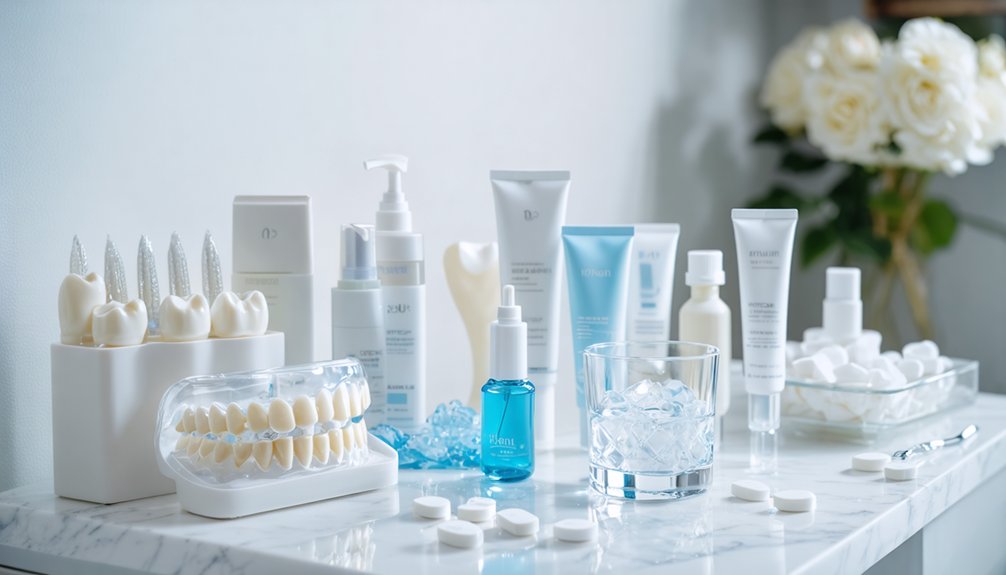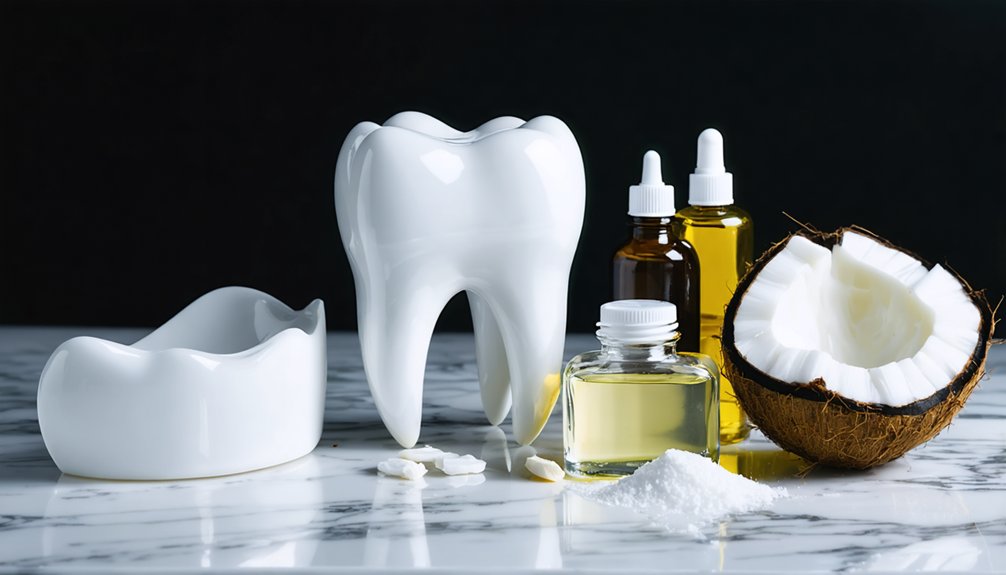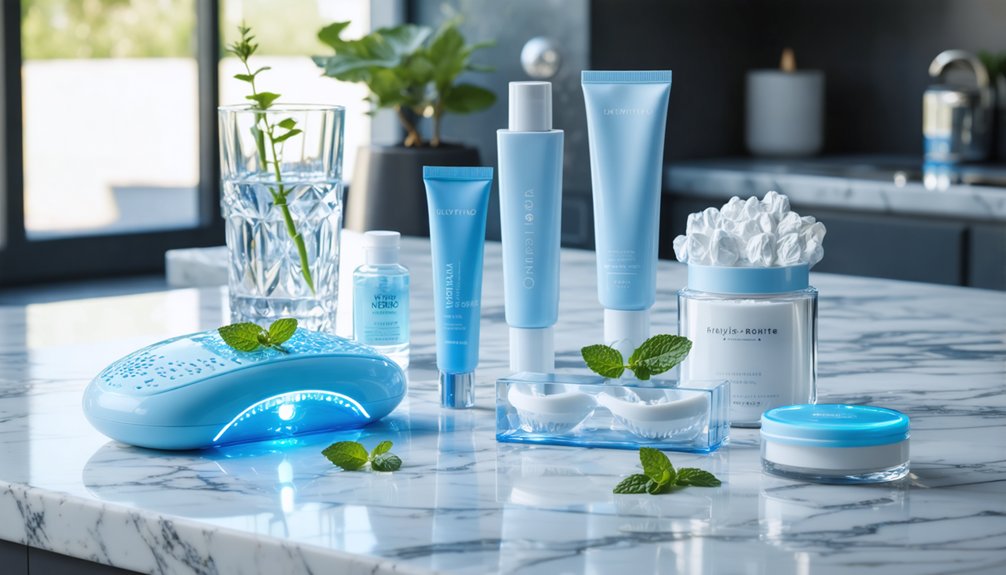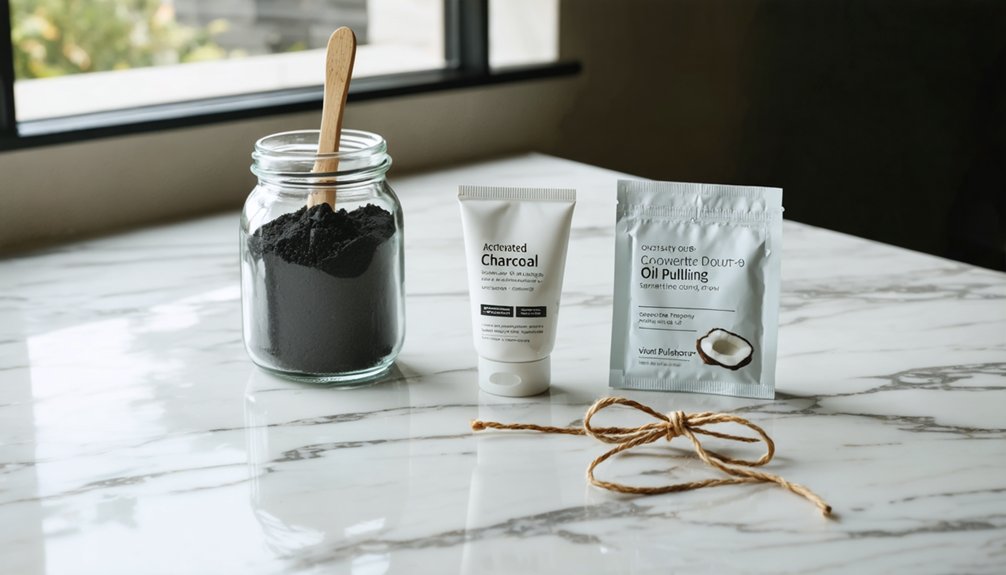You’ll find several effective whitening options designed specifically for sensitive teeth. Professional treatments include in-office procedures, LED whitening, and custom-fitted trays that offer controlled application. Over-the-counter solutions feature sensitivity-focused strips, gentle whitening toothpastes with desensitizing agents, and natural approaches like baking soda treatments. For best results, start with low-strength products and gradually progress to stronger options while monitoring your comfort level. Understanding the full range of treatments can help you make an informed choice for your situation.
Key Takeaways
- Professional dental whitening methods offer controlled approaches including in-office treatments, laser whitening, and LED whitening with sensitivity management.
- Over-the-counter whitening strips with ADA Seal of Acceptance provide effective and comfortable whitening for sensitive teeth.
- Whitening toothpastes containing desensitizing agents like potassium nitrate and stannous fluoride offer gentle daily maintenance.
- Natural alternatives such as baking soda and calcium carbonate provide low-abrasion cleaning while being gentle on sensitive teeth.
- At-home whitening systems with lower peroxide concentrations, like Crest 3DWhitestrips Sensitive, offer structured approaches for sensitive teeth.
Understanding Tooth Sensitivity and Whitening
While tooth sensitivity affects millions of people worldwide, it’s particularly relevant when considering teeth whitening treatments.
If you’re among the 1 in 8 Americans with sensitive teeth, you’ll need to approach whitening with extra caution. Your sensitivity likely stems from exposed dentinal tubules due to worn enamel or receding gums, making your teeth more susceptible to whitening effects. Proper oral hygiene remains essential for managing sensitivity before attempting any whitening procedures.
Using a desensitizing toothpaste can help reduce discomfort before and during whitening treatments.
Understanding your specific sensitivity pattern matters, as the sharp, sudden pain you experience from hot, cold, or acidic stimuli indicates how your teeth might react to whitening agents.
Since sensitivity often becomes chronic, lasting more than two years in most cases, you’ll need to balance your desire for whiter teeth with your comfort level. This is especially important if you’re female or younger, as these demographics show higher sensitivity rates.
Professional Dental Whitening Methods
For those with sensitive teeth, professional dental whitening methods offer carefully controlled approaches that balance effectiveness with comfort.
Under professional supervision, you’ll find several customization options designed to minimize discomfort while achieving desired results.
In-office whitening provides immediate results through concentrated whitening agents, while laser teeth whitening uses precise laser technology to activate the bleaching process. Peroxide-based chemicals used in professional treatments can achieve dramatic improvements in a single visit.
LED whitening offers a gentler approach, using light activation to enhance the whitening effect while managing sensitivity.
For at-home care, tray-based whitening allows for controlled application with custom-fitted trays.
In cases of non-vital teeth, intracoronal bleaching provides targeted treatment by applying agents directly inside the tooth.
Your dentist will help determine which method best suits your sensitivity level and whitening goals.
Professional whitening treatments can lighten teeth up to eight shades within a single session.
Over-the-Counter Solutions for Sensitive Teeth
Choosing the right over-the-counter whitening solution requires careful consideration when you have sensitive teeth. For OTC whitening options, whitening strips designed specifically for sensitivity, like Crest 3D White Whitestrips Gentle Routine and Rembrandt strips, offer effective stain removal while minimizing discomfort. They outperform traditional whitening toothpastes and mouthwashes. Gentle 30-day schedule makes these strips more comfortable for sensitive teeth. Looking for products with the ADA Seal of Acceptance helps ensure both safety and effectiveness for sensitive teeth. While whitening gels and pens provide convenience, they’re typically less reliable for sensitivity management due to inconsistent application. Non-custom tray kits can cause increased irritation from poor fit.
If you’re extremely sensitive, consider peroxide-free alternatives, though they’re less effective and mainly address surface stains. Remember that no OTC product matches professional-grade customization, and proper usage is critical – overuse of any whitening product can worsen sensitivity and damage oral tissues.
Gentle Whitening Toothpastes and Daily Care
When selecting a whitening toothpaste for sensitive teeth, you’ll want to focus on products containing proven desensitizing agents like potassium nitrate (5%) and stannous fluoride, which effectively calm nerve endings while providing gentle whitening action.
You should maintain consistent twice-daily brushing with these specialized formulations, using a soft-bristled brush to maximize sensitivity relief and whitening benefits. If sensitivity persists beyond four weeks of use, consult your dentist as this may indicate a more serious underlying condition.
Choosing toothpastes with natural ingredients helps ensure safe and effective whitening without harsh artificial additives. For best results, you’ll need to replace your toothbrush every three months while monitoring your teeth’s response to guarantee the whitening process remains comfortable and effective.
Desensitizing Ingredients Matter Most
Understanding the active ingredients in whitening toothpaste formulations proves vital for sensitive teeth management. When choosing a whitening toothpaste, you’ll want to focus on desensitizing agents that effectively target nerve pain while providing gentle whitening benefits.
Potassium nitrate, found in concentrations of 5%, works by blocking dental nerve pathways to reduce sensitivity. You’ll find it’s most effective when combined with sodium fluoride (0.24%), which strengthens enamel while fighting cavities. Daily brushing with a soft bristle toothbrush is essential for optimal results and comfort.
For those seeking fluoride-free options, nano-hydroxyapatite offers excellent remineralization properties while sealing exposed dentin. Natural ingredients like calcium carbonate provide gentle abrasion for effective cleaning and whitening. Baking soda serves as another gentle option, neutralizing acids while providing low-abrasion cleaning.
These active ingredients work systematically to address both sensitivity and whitening needs, making your choice of toothpaste vital for successful treatment.
Daily Brushing Best Practices
The proper implementation of daily brushing techniques forms the foundation of effective teeth whitening for sensitive teeth.
You’ll need to brush twice daily for at least one minute using a soft-bristled toothbrush and gentle circular motions to protect your gums.
When selecting your oral hygiene products, opt for gentle whitening toothpastes containing potassium nitrate and sodium fluoride, such as Sensodyne Gentle Whitening or Pronamel.
These formulations help remove surface stains while protecting your enamel and reducing sensitivity.
After brushing, spit out excess toothpaste and rinse thoroughly.
Maintain consistency in your product use to achieve ideal results.
Remember to avoid acidic foods and beverages that can erode enamel, and schedule regular dental check-ups to monitor your progress and adjust your brushing techniques as needed.
Natural Approaches to Teeth Whitening

For individuals with sensitive teeth seeking natural whitening solutions, several options exist that can provide gentler alternatives to harsh chemical treatments.
While baking soda benefits include mild abrasive properties for surface stain removal, you’ll need to use it sparingly to protect your enamel.
Despite popular trends, avoid activated charcoal risks, as it can permanently damage tooth structure.
When considering natural whitening approaches, focus on these evidence-based methods:
- Mix baking soda with small amounts of water for a gentle whitening paste
- Practice oil pulling with coconut oil for overall oral hygiene
- Avoid acidic fruits directly on teeth, as they erode enamel
Remember that natural solutions work gradually and require consistency.
If you experience increased sensitivity, discontinue use and consult your dental professional for personalized recommendations.
At-Home Whitening Systems and Safety
While natural remedies offer gentle whitening solutions, commercially available at-home whitening systems provide a more structured approach for those with sensitive teeth.
Products like Crest 3DWhitestrips Sensitive and GLO Science utilize specialized formulas with lower peroxide concentrations to minimize sensitivity triggers while still achieving noticeable results.
You’ll find most sensitive teeth whitening kits include clear instructions for whitening duration, typically recommending 5-14 days of controlled use.
It’s essential to follow these guidelines precisely and consult your dentist before starting treatment, especially if you have untreated dental issues.
Look for products containing desensitizing agents like potassium nitrate or fluoride, and choose systems with custom-fit strips or trays to prevent gum irritation.
These safer options can effectively whiten your teeth while protecting sensitive areas from discomfort.
Expert Tips for Long-Term Success

You’ll need to closely monitor your dental health through regular check-ups and immediate attention to any sensitivity issues that arise during your whitening journey.
Building a sustainable whitening routine means selecting gentle products, maintaining consistent oral care habits, and spacing out touch-up treatments to protect your enamel’s integrity.
Starting with lower-concentration whitening agents and gradually increasing exposure will help you confidently achieve your desired results while minimizing discomfort and potential sensitivity issues.
Monitor Your Dental Health
Maintaining ideal dental health requires consistent monitoring and professional oversight during any teeth whitening journey. Schedule regular dental check-ups every 3-6 months for thorough oral assessments and professional cleanings to track your progress and address any emerging sensitivity issues.
Your dental monitoring plan should include:
- Using desensitizing toothpaste before and during treatments to minimize discomfort.
- Tracking sensitivity levels and immediately reporting increased discomfort to your dentist.
- Documenting changes in tooth color and gum health through photos or clinical records.
Stay committed to proper oral hygiene practices, including gentle brushing with a soft-bristled toothbrush and daily flossing.
Avoid tobacco, limit acidic foods, and maintain adequate hydration to support your enamel’s health during the whitening process. Your dentist will adjust your treatment plan based on these ongoing assessments.
Choose Sustainable Methods
Beyond regular monitoring, achieving lasting whitening results demands sustainable methods that protect both your teeth and the environment.
Consider adopting eco-friendly ingredients like baking soda mixed with coconut oil for gentle stain removal, or try oil pulling as a daily practice to reduce bacteria and maintain whiteness naturally.
You’ll find sustainable whitening success by incorporating crunchy fruits and vegetables into your diet while avoiding staining substances like coffee and wine.
When selecting products, opt for bamboo-based charcoal toothpastes and biodegradable packaging.
For enhanced results, combine natural whitening agents like diluted hydrogen peroxide with baking soda, but use sparingly to protect sensitive teeth.
These methods not only safeguard your enamel but also support environmental consciousness through reduced chemical exposure and waste.
Start Gradually, Build Confidence
When approaching teeth whitening with sensitive teeth, starting gradually allows your enamel to adapt while building lasting results. Through gradual exposure to whitening agents, you’ll develop confidence in managing sensitivity while achieving your desired smile.
Begin with shorter sessions and increase duration as your tolerance builds.
For ideal confidence building during your whitening journey:
- Start with a low-strength whitening rinse or sensitive-formulated strips for 5 minutes
- Progress to custom-fitted trays with PAP-based solutions after two weeks
- Incorporate desensitizing pre-treatments before advancing to longer sessions
Monitor your teeth’s response and adjust accordingly.
Using fluoride toothpaste between sessions strengthens enamel, while maintaining regular dental check-ups ensures you’re progressing safely.
Frequently Asked Questions
Can Antibiotics or Medications Affect the Success of Teeth Whitening Treatments?
Particularly powerful medications, especially tetracycline antibiotics, can permanently prevent your teeth from whitening effectively. You’ll need extended treatment times or alternative options when dealing with these medication-related stains.
How Long Should I Wait Between Different Whitening Treatments or Methods?
You’ll need to wait at least two weeks between whitening treatments to reduce sensitivity. Treatment intervals depend on your sensitivity level, whitening method, and your dentist’s professional guidance.
Does Whitening Sensitivity Differ Between Upper and Lower Teeth?
Like mirror images in their response, your upper teeth sensitivity matches your lower teeth sensitivity. Studies show no significant difference between them, as both share similar dentin and pulp structures.
Can Previous Dental Work Impact Which Whitening Methods I Should Choose?
Your previous work greatly affects your treatment options. You’ll need to take into account that crowns, veneers, and fillings won’t whiten like natural teeth, so consult your dentist for appropriate whitening methods.
Does Age or Genetics Play a Role in Tooth Sensitivity During Whitening?
Yes, your age affects tooth enamel thickness, while your genetic predisposition influences sensitivity. You’ll experience varying levels of whitening discomfort based on these factors, which can impact treatment choices.
References
- https://buforddentist.com/what-are-the-best-whitening-options-for-sensitive-teeth/
- https://pmc.ncbi.nlm.nih.gov/articles/PMC4058574/
- https://www.clearwavedental.com/comparing-different-teeth-whitening-methods
- https://deefordentist.com/whitening-methods-for-sensitive-teeth/
- https://www.parkcreekdentalcare.com/blog/teeth-whitening-for-sensitive-teeth-safe-options-that-work/
- https://supremiadentistry.com/the-5-best-ways-to-whiten-sensitive-teeth/
- https://truesmileworks.com/which-teeth-whitening-method-is-best-for-sensitive-teeth/
- https://pmc.ncbi.nlm.nih.gov/articles/PMC10873745/
- https://healthcare.utah.edu/healthfeed/2023/12/perils-of-sensitive-teeth
- https://pmc.ncbi.nlm.nih.gov/articles/PMC11326452/



